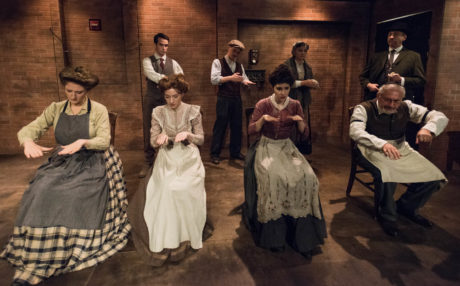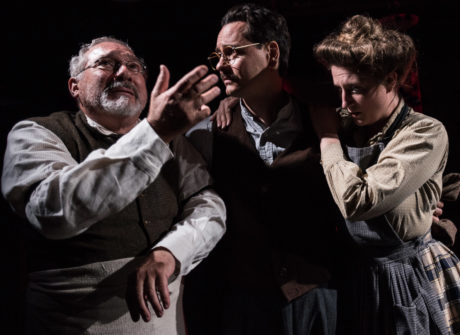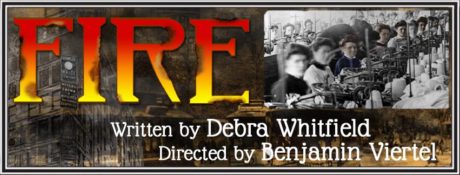On March 25, 1911, fire raged through the 8th to 10th floors of the Triangle Shirtwaist Factory by Washington Square Park. In less than 20 minutes, it claimed the lives of 146 people, mostly teenaged female immigrants who were trapped inside, or who jumped to their deaths in an attempt to escape the ravaging smoke and flames rather than be suffocated or burned alive. This horrific tragedy – one of the worst in the annals of New York City and the industrial history of our country – is the inspiration for Fire, making its world premiere with Chatillion Stage Company in Theatre 54 at Shetler Studios and Theatres.
Written by Chatillion’s Artistic Director Debra Whitfield and directed by Benjamin Viertel, the company’s compelling debut production presents a heartrending fictionalized account of the disaster and the inhumane working conditions that exacerbated it, imagining the circumstances and backstories of victims and survivors who had come to America in search of a better life, and interweaving actual testimony recorded in extant court documents from the trial against the sweatshop’s greedy, abusive, and negligent owners. In so doing, the show significantly underscores the impact the infamous fire had on the history of the American working class, spurring the growth of the International Ladies’ Garment Workers’ Union (ILGWU) and government legislation on fire codes and fire prevention in the workplace.

Set at various locales in the city, from the factory to the characters’ homes to the courtroom, the short vignettes in Whitfield’s non-linear narrative move back and forth in time, giving us glimpses of the personal stories before, during, and after the fire. An engaging cast of eight – Laura King Otazo, Malka Wallick, Lauriel Friedman, Stuart Zagnit, Jake Horowitz, Kevin Lowry, Paulette Oliva, and Jay Russell – takes on multiple roles, each assuming the old-fashioned ethnic characterizations, class distinctions, and accents (with dialect coaching by Colleen Gleason) that bespeak the established social order and bigotry that have marred our melting-pot culture. Though some of the shifts in character are at times confusing (with only minimal changes in costume accessories to help us identify them), the actors generally capture the individual personalities and define their situations with believable emotion and psychology.
Portraying the central trio of working girls, especially noteworthy performances are turned in by Friedman as Rosa, a young Italian immigrant who, despite being afflicted with the flu, understands the need to go in to the factory to support her family, as well as the need for a union to advocate on behalf of the workers; Wallick as Anna, a transplant from Eastern Europe who is conflicted about marrying her fiancé because of the dark secret she keeps hidden; and Otazo as Maeve, an Irish woman whose cheerful demeanor provides a much-needed spirit of support and camaraderie for her co-workers. Among the men, Zagnit is convincingly passionate as the Jewish tailor whose son wants to become a lawyer instead of following in the footsteps of his family tradition, and Russell is thoroughly despicable as Mr. Blanck, the boss who treats his underpaid employees as chattel and imperiously subjects them to the deplorable conditions that result in an unnecessarily high death toll.
Realistic scenes of the main characters are interspersed with highly stylized sequences of dance and fashion commentary that are in tune with the current trend of movement-based segments but seem out of time with the era; they do, however, serve to provide a telling contrast between the upscale venues and shops patronized the wealthy clientele who bought the clothes produced in the factory, and the meagre lives of the struggling workers who made them. Other problems and anachronisms are evident in the show’s artistic design. Black-and-white projections, designed by Bryce Cutler to indicate the dates and places of the scenes, are hindered by bad sightlines that block their visibility for audience members seated to the left of center. Cutler’s set, and props by Debra Moolin – including old-time wooden furniture, lighting fixtures, machinery, and the backdrop of a brick wall – suggest the early years of the 20th century, but the red neon lights, aluminum foil, and perfectly rectilinear panels of falling walls that are supposed to conjure the flames, smoke, and damage caused by the historic inferno, have a decidedly post-modern look, and render subsequent scenes, which are supposed to pre-date the catastrophe, visually illogical.

Despite the noted inconsistencies, other elements of the design are impressive. Emily Chalmers pays homage to the theme of the garment industry with outstanding vintage-style costumes in fabrics and fittings that evoke the era (with hair and make-up consultation provided by Inga Thrasher). Deborah Constantine’s beautiful lighting brings dramatic focus to the changing scenes, as Viertel efficiently moves the ensemble around the wide and shallow stage space. And Carlene Stober and Ed Matthew create a redolent soundscape of original music and cogent aural effects that enhance the action.
Fire is most successful in its sympathetic recognition of humanity – in allowing us to see those who were lost over a century ago as not mere statistics, but as human beings. It also triumphs in its reaffirmation of the socio-political need for unionization and safety regulations to protect the rights of our workers and to preserve the lives of our diverse population, in our common ongoing quest to realize the American dream.
Running Time: 80 minutes, without intermission.
Fire plays through Saturday, October 28, 2017, at Chatillion Stage Company, performing at Theatre 54 at Shetler Studios and Theatres – 244 West 54th Street, 12th floor, NYC. For tickets, purchase them online.





